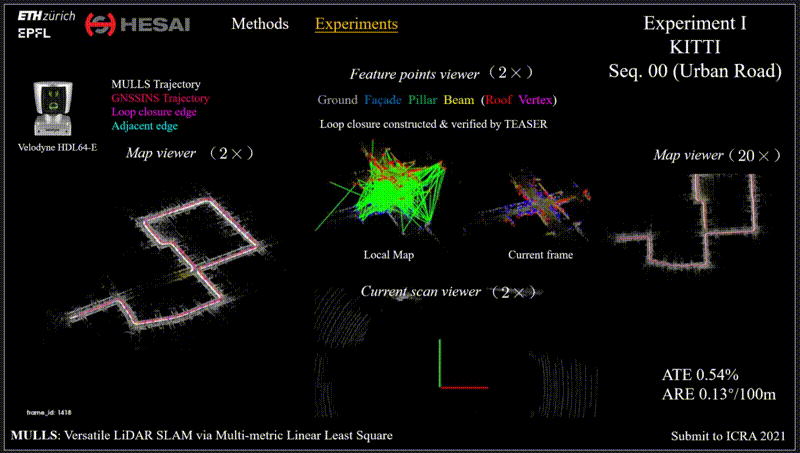This repository implements MULLS, an efficient, low-drift, and versatile LiDAR-only SLAM system with both the front-end and back-end. It's an overall updated version of LLS-LOAM.
Version 1.1
(tested on Ubuntu 16.04 / 18.04 / 20.04)
Codes are currently under refactoring for better readability and performance.
For a compiler that supports OpenMP
Compulsory:
Optional:
- For *.las data IO: LibLas
- For *.h5 data IO: HDF5
- For geo-coordinate projection for global mapping: Proj4
- For Lie-Group and Lie-Algebra related functions (only used in baseline registration method vgicp): Sophus
- For 2D map, scan range image and BEV image generation: OpenCV
- For pose graph optimization: g2o(<=2016version)
- or ceres
- or gtsam
- For efficient global registration using truncated least square: TEASER++
You may run the following shell file to install all the dependent libs (tested on Ubuntu 16.04):
sh script/tools/install_dep_lib.sh
Note: ceres, g2o and gtsam are all used for pose graph optimization. You only need to install one of them (ceres is recommended).
# cd to the base folder of MULLS
mkdir build
cd build
cmake ..
make
cd ..
If you'd like to configure the optional dependent libs needed by your task, you can directly switch the options in CMakeLists.txt and then rebuild or use ccmake .. in build folder instead. (If it does not work, you nned to delete the build folder and do 2.Compile again).
By using the example data (16 adjacent scans) in ./demo_data, you can have a quick test of MULLS-SLAM and MULLS-Registration.
Without editing anything, directly run
sh script/run_mulls_slam.sh
and
sh script/run_mulls_reg.sh
to check the results (in the real-time viewer and the result folder in demo_data).
The input of MULLS should be a sequence of point cloud. Each point cloud is corresponding to a frame of the transaction.
Download the KITTI Odometry Dataset to test the project.
To test the semantic mask aided solution, please download the Semantic KITTI Odometry Dataset.
The complete data folder structure should be as following:
Base Folder
_____00
|___velodyne [raw data *.bin]
|___pcd [*.pcd] (can be generated from *.bin by run_kittibin2pcd.sh)
|___labels [raw semantic label *.label] (optional for semantic aided lidar odometry)
|___label_pcd [*.pcd] (optional for semantic aided lidar odometry, can be generated from *.label and *.bin by run_semantic_kitti_labelbin2pcd.sh)
|___00.txt [ground truth (gnssins) pose] (optional for evaluation)
|___calib.txt [extrinsic transformation matrix (from body to lidar coordinate system)] (optional for evaluation)
|___result [output of MULLS: generated map, pose and evaluation] (would be generated automatically after the transaction)
_____01
|___velodyne
|___pcd
|___labels
|...
_____...
Scripts for converting the data format are available in ./script/tool/ folder.
You can use script/tools/run_kittibin2pcd.sh to convert *.bin to *.pcd to get the pcd folder.
Similarly, you can use script/tools/run_semantic_kitti_labelbin2pcd.sh to convert *.label to *.pcd to get the label_pcd folder.
If you'd like to use your own data, the data format should be one of the following: *.pcd, *.ply, *.txt, *.las, *.csv, *.h5, *.bin.
You can simply specify the data format in script/run_mulls_slam.sh.
The data foler structure can be as simple as follows:
Base Folder
|___dummy_framewise_point_cloud
. |___00001.pcd (las,txt,ply,h5,csv,bin...)
. |___00002.pcd (las,txt,ply,h5,csv,bin...)
. |___...
|___dummy_ground_truth_trajectory.txt (optional)
|___dummy_calibration_file.txt (optional)
To feed your data into MULLS in order, your point clouds' filename should also in the same order. You can use script/tools/batch_rename.sh to rename filenames from something like 1.pcd to 00001.pcd in batch.
Links to more open datasets are available here.
If you'd like to test the LiDAR SLAM module (MULLS-SLAM), please edit the script/run_mulls_slam.sh file, specify the data path and then run:
sh script/run_mulls_slam.sh
If the visualization is enabled, then you can configure the visualization GUI by following the instructions here.
For better performance on a specific dataset, you are suggested to play with the parameters in script/config/lo_gflag_list_[xxx].txt (tips on parameter tuning are available here), and then you need to change the config file path in script/run_mulls_slam.sh as follows:
config_file=./script/config/lo_gflag_list_[xxx].txt
To disable or enable the back-end (loop closure detection and pose graph optimization), you can edit the --loop_closure_detection_on=true/false in the config file.
After the transaction, you are expected to find the results (plots, poses, evaluation results, generated 3D and 2D map ...) in the result folder under the data path. You can configure the output preference according to here.
You can use script/run_mulls_reg.sh to test the pairwise point cloud registration using MULLS-ICP with TEASER++ simply by configuring the data path in it. Then you can run it by:
sh script/run_mulls_reg.sh
An example on TLS point cloud registration can be found here.
If you find this code useful for your work or use it in your project, please consider citing the paper:
@inproceedings{pan2021mulls,
title={MULLS: Versatile LiDAR SLAM via Multi-metric Linear Least Square},
author={Yue Pan, Pengchuan Xiao, Yujie He, Zhenlei Shao, Zesong Li},
booktitle={IEEE International Conference on Robotics and Automation (ICRA)},
year={2021},
organization={IEEE}
}
If you have any questions, please let me know:
- Yue Pan {yuepan@ethz.ch}
We thank the authors of TEASER and NDT_OMP for making their work public.
Thanks Martin Valgur @valgur for fixing the compatibility issues.
- Add preprint paper
- Add Wiki
- Add demo examples
- Update camera-ready paper
- Code refactoring
- Add ROS support
- Add cross-platform support (run on windows)
- Add sensor fusion module
- Add localization module with built map



